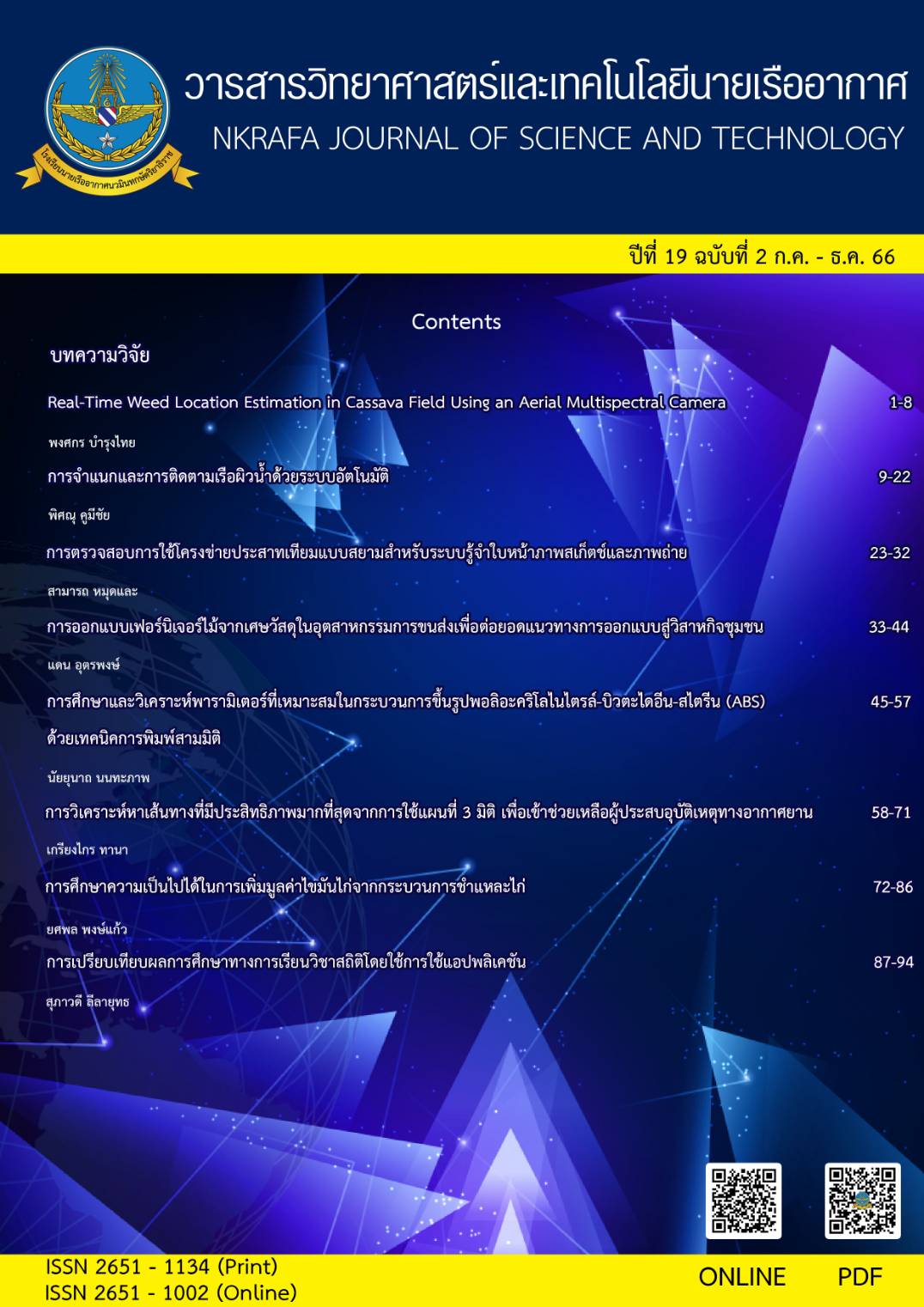การจำแนกและการติดตามเรือผิวน้ำด้วยระบบอัตโนมัติ
Main Article Content
บทคัดย่อ
ในเทคโนโลยีการขับขี่อัตโนมัติของเรือผิวน้ำกล้องเป็นสิ่งจำเป็นสำหรับการกำหนดเส้นทางและการตรวจจับวัตถุ เพื่อหลีกเลี่ยงสิ่งกีดขวางหรือหลีกเลี่ยงการชนกันของเรือ สิ่งที่สำคัญคือการติดตามการเคลื่อนไหวของเรือที่รู้จัก ในบทความนี้ได้ใช้ชุดข้อมูลการเดินเรือของไทย และการรวบรวมภาพข้อมูลสำหรับแบบจำลองฝึกอบรม จากนั้นจะนำเสนอการจดจำวัตถุด้วยวิธี AlexNet ด้วยการจำลองและประเมินผลการปฏิบัติงานในสภาพแวดล้อมการเดินเรือที่แตกต่างกัน จากนั้นจะเสนออัลกอริทึมการติดตามเพื่อติดตามวัตถุที่ระบุโดยเฉพาะอย่างยิ่งในการประเมินผลด้วยวิดีโอที่มีการเคลื่อนไหวสูง ผลการทดลองแสดงถึงอัลกอริทึมการติดตามมีประสิทธิภาพสูงกว่าการติดตามแบบออนไลน์และเรียลไทม์ในเชิงลึกในแง่ของความแม่นยำในการติดตามวัตถุ
Article Details

This work is licensed under a Creative Commons Attribution-NonCommercial-NoDerivatives 4.0 International License.
- เนื้อหาและข้อมูลในบทความที่ตีพิมพ์ในวารสารวิทยาศาสตร์และเทคโนโลยีนายเรืออากาศ ถือเป็นข้อคิดเห็นและความรับผิดชอบของผู้เขียนบทความโดยตรง กองบรรณาธิการวารสาร ไม่จำเป็นต้องเห็นด้วย หรือร่วมรับผิดชอบใด ๆ
- บทความ ข้อมูล เนื้อหา รูปภาพ ฯลฯ ที่ได้รับการตีพิมพ์ในวารสารวิทยาศาสตร์และเทคโนโลยีนายเรืออากาศถือเป็นลิขสิทธิ์ของวารสารวิทยาศาสตร์และเทคโนโลยีนายเรืออากาศ หากบุคคลหรือหน่วยงานใดต้องการนำทั้งหมดหรือส่วนหนึ่งส่วนใดไปเผยแพร่ หรือเพื่อกระทำการใด ๆ จะต้องได้รับอนุญาตเป็นลายลักอักษรณ์จากวารสารวิทยาศาสตร์และเทคโนโลยีนายเรืออากาศ ก่อนเท่านั้น
References
Redmon, J.; Divvala, S.; Girshick, R.; Farhadi A. (2016). You only look once: Unified, real-time object detection. In Proceedings of the IEEE Conference on Computer Vision and Pattern Recognition, Las Vegas, NV, USA, 27–30 June 2016; pp. 779–788.
Zhang, Y.; Wang, C.; Wang, X.; Zeng,W.; Liu,W. Fairmot. (2020). On the fairness of detection and re-identification in multiple object tracking. arXiv 2020, arXiv:2004.01888.
Bewley, A.; Ge, Z.; Ott, L.; Ramos, F.; Upcroft, B. (2016). Simple online and realtime tracking. In Proceedings of the 2016 IEEE International Conference on Image Processing (ICIP), Phoenix, AZ, USA, 25–28 September 2016; pp. 3464–3468.
Wojke, N.; Bewley, A.; Paulus, D. (2017). Simple online and realtime tracking with a deep association metric. In Proceedings of the 2017 IEEE International Conference on Image Processing (ICIP), Beijing, China, 17–20 September 2017; pp. 3645–3649.
Lee, S.J.; Roh, M.I.; Oh, M.J. (2020). Image-based ship detection using deep learning. Ocean. Syst. Eng. 2020, 10, 415–434.
Jie, Y.; Leonidas, L.; Mumtaz, F.; Ali, M. (2021). Ship detection and tracking in inland waterways using improved YOLOv3 and Deep SORT. Symmetry 2021, 13, 308.
Huang, H.; Sun, D.; Wang, R.; Zhu, C.; Liu, B. (2020). Ship target detection based on improved YOLO network. Math. Probl. Eng. 2020, 9440212.
Chen, X.; Qi, L.; Yang, Y.; Luo, Q.; Postolache, O.; Tang, J.; Wu, H. (2020). Video-based detection infrastructure enhancement for automated ship recognition and behavior analysis. J. Adv. Transp. 2020, 7194342.
Chen, X.; Xu, X.; Yang, Y.; Wu, H.; Tang, J.; Zhao, J. (2020). Augmented ship tracking under occlusion conditions from maritime surveillance videos. IEEE Access 2020, 8, 42884–42897.
Girshick, R.; Donahue, J.; Darrell, T.; Malik, J. (2014). Rich feature hierarchies for accurate object detection and semantic segmentation. In Proceedings of the IEEE Conference on Computer Vision and Pattern Recognition, Columbus, OH, USA, 23–28 June 2014; pp. 580–587.
Deriche, R. (1987). Using Canny’s criteria to derive a recursively implemented optimal edge detector. Int. J. Comput. Vis. 1987, 1, 167–187.
Harris, C.; Stephens, M. (1988). A combined corner and edge detector. In Proceedings of the Alvey Vision Conference, Manchester, UK, 31 August–2 September 1988; Volume 15, pp. 10–5244.
Dalal, N.; Triggs, B. (2005). Histograms of oriented gradients for human detection. In Proceedings of the 2005 IEEE Computer Society Conference on Computer Vision and Pattern Recognition (CVPR’05), San Diego, CA, USA, 20– 25 June 2005; pp. 886–893.
Lowe, D.G. Distinctive image features from scale-invariant keypoints. Int. J. Comput. Vis. (2004), 60, 91–110.
Simonyan, K.; Zisserman, A. (2014). Very deep convolutional networks for large-scale image recognition. arXiv 2014, arXiv:1409.1556.
He, K.; Zhang, X.; Ren, S.; Sun, J. (2016). Deep residual learning for image recognition. In Proceedings of the IEEE Conference on Computer Vision and Pattern Recognition, Las Vegas, NV, USA, 27–30 June 2016; pp. 770–778.
Redmon, J.; Farhadi, A. (2017). YOLO9000: Better, faster, stronger. In Proceedings of the IEEE Conference on Computer Vision and Pattern Recognition, Honolulu, HI, USA, 21–26 July 2017; pp. 7263–7271.
Redmon, J.; Farhadi, A. (2018). Yolov3: An incremental improvement. arXiv 2018, arXiv:1804.02767.
Bochkovskiy, A.; Wang, C.Y.; Liao, H.Y.M. (2020). Yolov4: Optimal speed and accuracy of object detection. arXiv 2020, arXiv:2004.10934.
Krizhevsky, A., Sutskever, I., & Hinton, G. E. (2012). Imagenet classification with deep convolutional neural networks. In Advances in neural information processing systems (pp. 1097-1105).
Artificial Neural Networks. (2566). (อาทฟิคเคล นิวรอล เน็ตเวริค) คืออะไร โครงข่ายประสาทเทียม. (ออนไลน์). สืบค้นเมื่อ 9 เมษายน 2566, แหล่งที่มา https://shorturl.asia/PYZ2v.
LeCun, Y., Bottou, L., Bengio, Y., & Haffner, P. (1998). Gradient-based learning applied to document recognition. Proceedings of the IEEE, 86(11), 2278-2324.
Krizhevsky, A., Sutskever, I., & Hinton, G. E. (2012). ImageNet classification with deep convolutional neural networks. In Advances in neural information processing systems (pp. 1097-1105).
Alexnet architecture. (2566). Alexnet architecture (ออนไลน์). สืบค้นเมื่อ 9 เมษายน 2566, แหล่งที่มา https://shorturl.asia/BD9rC.

